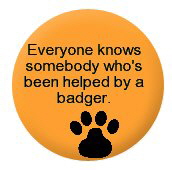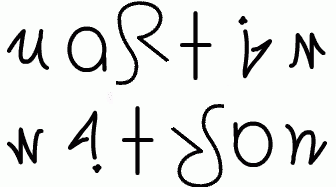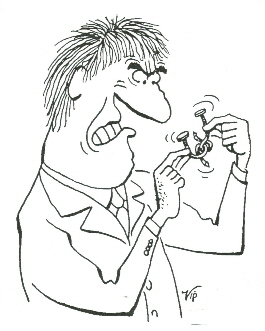|
Something will go here one day soon...Gaiety, merriment and dancing, etc. |
||||
 |
||||
|
Regular visitors here will have noticed the refurbishment is taking longer than expected. This is mainly due to me getting very hooked on tracing my family history, which seems to have more skeletons than a medieval plague pit, and as many black sheep as a farm with several black sheep. |
||||
 |
|||||||||||
|
|||||||||||
|
26th April 2016 - It was with very great sadness that I heard that our very good friend Robert Reid died earlier today. Since I was a child I have enjoyed mathematical and puzzling things. I don’t remember actually starting to collect mechanical or ‘real’ puzzles. One day I just realised that I had a few. It’s hard to remember from whence they came Probably from evil aunts and uncles who didn’t realise that at that age, what you might call “British-child-shoe-size-old”, that I had enough to worry about. That was in the days when Sir Winston Churchill was still alive, my bare knees got cold at school and England was yet to win a Football World Cup.
Recent discoveries and Puzzle News are here. Links to puzzles in my collection. Many more coming soon: 72057594090893376 Puzzles, Mechanical, Boxes 1_2, 4 & 5 40 items 72057594090887871 Puzzles, Mechanical, Box 1_1 18 items 72057594090901188 Puzzles, Mechanical, Chest 2 39 items 72057594090899948 Puzzles, Mechanical, Chest 1 66 items 72057594090906516 Puzzles, Mechanical, Rooms 5 & 6 41 items 72057594090904813 Puzzles, Mechanical, Rooms 3 & 4 49 items 72057594090902607 Puzzles, Mechanical, Room 1 & Geometry 29 items 72057594090909410 Puzzles, Mechanical, Room USA 59 items 72057594088873316 Puzzles, Mechanical, Batch Two 10 items 72057594085948056 Puzzles, Mechanical, Batch One 82 items 72057594090897589 Puzzles, Mechanical Cabinet 2 & 3 68 items
I recall having small plastic 4x4 versions of the 15-puzzle, and also a similar version with letters. I remember the pleasure I discovered after getting 1-2-3 in place and then working out the shift-sequence for getting the 4 in place. Somehow the edges of the tray always seemed to break, and the tiles would fall out. In later years I recall having a big boy’s version with many more tiles, featuring a map of the world. Who knows what happened to it, but I did buy a replacement copy a few years ago as an adult - or was it by chance the same one, having engrossed several more generations of puzzler in between times... I remember very clearly, aged 10, (I still wore small shoes...) in bed one Tuesday night, working out that if 1+100=101, and 2+99=101 etc that I could add up all the numbers from one to a hundred in my head. I was very pleased with myself. I remember at primary school, having a maths teacher (it has always seemed so unfair that in England we do ˜maths” but in the US they only have to do one of them...) called Mr. Beaumont who encouraged my interest in number systems, Napier’s Bones, geometry and polyhedra. Having a childhood love of numbers, and having only recently started wearing glasses, I somehow acquired the nickname “Professor”. Girls were a mystery to me then... I probably believed that Magic Squares truly were magic!
It is hard to remember exact dates on which to hang specific memories, but I started senior school in September 1968 and, sometime soon after, I can remember exactly where I was in the school grounds when someone gave me two small red shapes, which I was challenged to fit together to make a tetrahedron, although we probably called it a pyramid then. I was stunned by this marvel, which probably came out of a Christmas Cracker, and I still treasure those pieces today, although I have also got a set with bigger parts... (Many years later, my friend Sven who runs a puzzle shop in Majorca told me he had shown similar pieces to a small girl, and she found a way of making a square-based pyramid with them. I was stunned, to learn something new about one of my first puzzles. It shows how someone with a very open mind can see a new solution to an age-old problem. I also vividly recall cycling to the far end of Eastcote in NW London to the library, endlessly renewing “The Giant Colour Book of Mathematics” by Irving Adler. (Until today, I had never noticed the name of author) Its chapters on Square Roots, the Golden Section, Infinity and Mathematics for Fun caught my imagination at about the time my age entered double digits, an event of which I am still rightly proud. I have my own, worn, ex-jumble sale copy of the book now, and it is no less inviting, still only 91 pages long, but they were enormous pages for a 10-year old, and so full of colour, vibrancy and mystery. Long out of print, Amazon currently (2013) list their one copy at £40. (2016, it is £299!) One purchaser reviewed it like this, Someone bought me this book about 1960 when I was 7, and I loved the pictures. Over my schooldays, I gradually understood more and more of the book, and kept going back to it. I finally understood everything when I'd finished maths at university. I gave my book away 20 years ago to a 7-year-old. Now he's a Doctor. I just bought this one to give away to a 7-year old. I'll update the review in 20 years. I loved finding this listing. Great book, bit scruffy, but as advertised. Thanks! At some point about then I must have discovered the works of Martin Gardner, and instantly became a lifelong devotee, little knowing that one day I would count among my friends people who actually knew him. Likewise, I discovered how to turn empty cereal boxes into pentominoes, starting a respect for Solomon Golomb which I maintained, until it increased greatly on meeting him at puzzle parties. He was happy to autograph my dog-eared copy of his book and to stand for a photograph. Empty food boxes probably became the source of my very first set of Tower of Hanoi discs, lovingly inscribed on the slightly greasy, hard to write on, inside surface with a cheap compass and pencil, hacked out with kitchen scissors, and then the centres pierced with a pencil.
I also remember designing board games, even making my own dice from cardboard shapes with tabs, carefully folded and glued. I even made them extra-durable by filling them with dozens of squares of card to make them very solid, and then laminating them with Sellotape. I have still got some, somewhere! I made them so carefully that they were probably reasonably true or at least as reliable as my roulette wheel which I spun endlessly, recording every score, even though it came up “19” for more than seemed reasonable, even in my early teens. I think it is still in the loft, along with my detailed statistics. I have vague memories of owning one or two of the later, plastic-topped Journet puzzles, or perhaps they once belonged to my elder cousin. (What ever happened to the days when a child was happy with a cardboard box with a see-through top and a few indentations in the bottom and a few ball-bearings inside...? It still works for me!) My teens and twenties probably brought me their own share of puzzles and problems, but we now jump forward. I still possess a cube assembly puzzle, made from 6-7 white plastic pieces, which I have never been able to solve. I bought it in Hamley’s toy shop in Regent Street, London in the mid 1980s, and it was many years later before I discovered by computer that it was actually incompatible pieces from two separate sets, and that it was actually the world’s first Impossible Cube Assembly Puzzle. The pieces and box were loose on the shelf in the shop. Someone somewhere has another ill-matched set (that may perhaps be solvable?) I also remember the moment that I first handled a Rubik’s Cube. I was stunned in seconds when I realised its potential, little realising that I would eventually travel the (top half of the) globe, hunting for similar things, and even watch a performer solve one with one hand, while juggling two others in his left hand. I must do something with the film I shot. In the mid 1980s I discovered Covent Garden and Camden Markets, especially the stall of Kevin Holmes in the former and Village Games in the latter. Kevin became a good friend over the years, until his sad death, and I have lost count of the good times with Ray and Barbie(!) at Village Games. In the late 1980s I met another much-missed friend, Fred Armitage, and we spent many pints and many hours arguing over puzzles, maths and many other problems. It was in Village Games, soon after his return from Peru that I first met Robert Reid, a long-time inspiration and fellow gourmand. On to the early 1990s. I remember somehow agreeing to be visited by a glib-tongued financial advisor who sold me an endowment policy (I did subsequently get compensated for its mis-selling, but that is another story.) He mentioned a puzzle involving a large-headed nail in a block of wood. He told me that you had to balance 6 further nails on the head of the first. I still have the set I made from a bag of 6-inch nails and a wooden block from my local garden centre. In the mid 1990s I visited a pub near Oxford which had several quarter-inch wrought-iron disentanglement puzzles hanging up. I never discovered whether these were for shackling wobbly drinkers to the bar, but I soon tracked down the manufacturer after seeing similar items for sale in the now-long-closed Museum Shop in Kingston, SW London. Nearly twenty years ago they were a hefty £18 each, so I contacted Tucker-Jones in the US and ordered several at dollar equavalents. The sales lady told me that I would enjoy a book they sold, “Puzzles Old and New” by Jerry Slocum. I am not at all a soft touch, but I was talked into buying a copy, and I have never looked back. After paying the freight, customs, VAT and handling costs, I did not save anything, but it set me on the same road to ruin that many have followed before me, and looking far over my shoulder behind me I see that it is still a well-worn road. I also remember somehow finding Puzzle Wood in the Forest of Dean, the maze of pathways winding through the gulleys of mossy rocks, with twisted roots of yew trees and the bridges, lookouts and other things you can find on your way around. Shortly afterwards I bought my first Hanayama puzzle (A-B-C) from the gift shop at Symonds Yat near Ross-on-Wye. I was very impressed! In 1996 following a company merger I first had access (after work!) to the Internet, and, using Netscape Navigator I scoured this planet (and some smaller ones nearby) for the few puzzle suppliers with web sites. In 1998 I started my first web site, including pictures of puzzles. Into the new century and I have even had one or two original puzzle ideas, while standing on the shoulders of giants. Watson's Wormhole. . . . Digigrams. . . . Puzzle Food. . . . Dutch Cubist and quite a few others. In about 2000 I started geocaching, which is almost a mechanical puzzle. Subsequently I have visited the US four times, Japan twice, as well as Antwerp, Helsinki (where, against my better judgement I agreed to do a presentation on puzzle food and found that I made 200 people laugh for 10-15 minutes), Berlin, Prague, St Petersburg and Corsica while puzzle-hunting at International Puzzle Parties after Kevin Holmes and Ray Bathke convinced me to apply to attend the 1999 IPP in London. I remember the Founders’ Reception, on a hotel rooftop at Heathrow, meeting so many like-minded puzzle collectors about whom I had read, including Nob Yoshigahara, Serhiy Grabarchuk and Bill Cutler, and especially Allan Boardman who made me so very welcome. I met more new and lasting friends that evening than on any other day in my life. Then the next day I met the up-and-coming, down-and-out puzzle designer from Down Under, Brian ˜Mr Puddle” Young, hawking Australian cents in a funny-looking green box. A True Puzzle Story... Time, a greater maturity, and more experience of mechanical puzzles do not make the telling of the following story any easier. For me one of the big attractions of the 1999 International Puzzle Party in London was a visit to Edward Horden's house and large puzzle collection near Reading in Berkshire. At the time I didn't know Edward well, but had previously been in touch with him by snail mail in my efforts to get hold of a copy of his classic book, Sliding Piece Puzzles. It was therefore a great privilege to finally meet him. While I took many photographs, bought several puzzles from him, and went away with many memories, the greatest of these is the misfortune which befell me in his bathroom! After entering the room, securing the door and going about my business, I then attempted to leave. Unfortunately the door handle came off in my hands! Despite years of puzzle experience, including secret opening boxes, I was unable to release myself from the bathroom. I had to resort to banging loudly on the door when I heard somebody passing out side. A lady, still unknown to me to this day, released me from my temporary prison. I mumbled my thanks, and returned to my tour of Edward’s puzzle collection.
The following short film clip is of me showing and telling you how to take apart a 12 piece burr. I hope to record more films like this. As of early 2012 it had had 30,000 viewings, mostly for the t-shirt. (Early 2016, almost 50,000).
Future Plans I have so many plans for new material for this site, but I have many other distractions. Things I have planned include an article on 3D folding puzzles, puzzles which are designed to look like other puzzles, and electronic puzzles.
Over the years I have collected many hinged puzzles, like Rubik's Snake, various strings of polyhedra and other folding novelties. I have several puzzles which have been designed to look like something else, such as a puzzle which looks like a burr puzzle but assembles like a six-piece Rhombic Star. I also have electronic puzzles which purists may frown on, but I will leave that for you to decide. I consider them to be puzzles, rather than computer games.
|
|||||||||||
I started this web site in about 1998. As of Autumn 2016 it is getting its biggest ever refurbishment.My goals are to include more current information, more pictures, no dead links, consistent format and typeface, better readability on more screens, and to get rid of characters that display badly. But no free beer.It is a bit untidy and experimental ...but just wait...Text first, then pictures to be replaced. |







